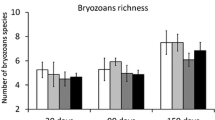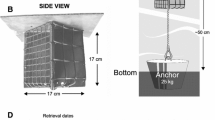Abstract
Predatory control of community structure, through consumption of herbivores and subsequent positive effects on the biomass or productivity of primary producers is common in marine ecosystems. We designed an experiment to analyse the effect of large-sized predators on the development of the macrofouling assemblage of a harbour. Predation was manipulated by randomly assigning artificial substrata to three treatments: (1) exclosure cages preventing access of large predators, (2) cage controls, i.e. cages with lateral walls but without roofs, allowing predators free access, (3) uncovered panels. Substrata were submersed horizontally and upper surfaces sampled at quarterly intervals over a 1-year period. No differences in species richness were observed among treatments but diversity was lower within exclosure cages than on cage controls/uncovered panels. In sessile assemblages, structure differed between treatments: cage controls/uncovered panels were dominated by algae and associated mesoherbivores, which were scarce/absent within cages. Exposure to predators also affected the structure of mobile assemblages. The sea urchin Pseudechinus magellanicus (Philippi) occurred within exclosure cages but was never found on exposed panels. We conclude that large predators exert a significant effect on assemblage structure and diversity, indirectly promoting the development of filamentous algae and mesoherbivores by controlling the abundance of browsers.



Similar content being viewed by others
References
Anderson, M. J., 2005. PERMANOVA: a FORTRAN computer program for permutational multivariate analysis of variance. Department of Statistics, University of Auckland, New Zealand.
Anderson, M. J. & S. D. Connell, 1999. Predation by fish on intertidal oysters. Marine Ecology Progress Series 187: 203–211.
Ayling, A. M., 1981. The role of biological disturbance in temperate subtidal encrusting communities. Ecology 62: 830–847.
Barrientos, C. A., M. T. González & C. A. Moreno, 2006. Geographical differences in the feeding patterns of red rockfish (Sebastes capensis) along South American coasts. Fishery Bulletin 104: 489–497.
Bastida, R., 1973. Studies of the fouling communities along Argentine coasts. In Acker, R. F., B. F. Brown, J. R. De Palma & W. P. Ivarson (eds), Proceedings of the 3rd International Congress on Marine Corrosion and Fouling. National Bureau of Standards Special Publications, Washington, DC: 847–864.
Bates, C. R., 2009. Host taxonomic relatedness and functional-group affiliation as predictors of seaweed-invertebrate epifaunal associations. Marine Ecology Progress Series 387: 125–136.
Bates, C. R. & R. E. DeWreede, 2007. Do changes in seaweed biodiversity influence associated invertebrate epifauna? Journal of Experimental Marine Biology and Ecology 344: 206–214.
Bertness, M. D., C. M. Crain, B. R. Silliman, M. C. Bazterrica, M. V. Reyna, F. Hidalgo & J. K. Farina, 2006. The community structure of western Atlantic Patagonian rocky shores. Ecological Monographs 76: 439–460.
Bishop, M. J. & P. A. Hutchings, 2011. How useful are port surveys focused on target pest identification for exotic species management? Marine Pollution Bulletin 62: 36–42.
Bortolus, A. & E. Schwindt, 2007. What would Darwin have written now? Biodiversity and Conservation 16: 337–345.
Brown, K. M. & D. C. Swearingen, 1998. Effects of seasonality, length of immersion, locality and predation on an intertidal fouling assemblage in the Northern Gulf of Mexico. Journal of Experimental Marine Biology and Ecology 225: 107–121.
Choat, J. H., 1982. Fish feeding and the structure of benthic communities in temperate waters. Annual Review of Ecology and Systematics 13: 423–449.
Clarke, K. R. & R. M. Warwick, 2001. Change in Marine Communities: An Approach to Statistical Analyses and Interpretation, 2nd ed. PRIMER-E Ltd, Plymouth.
Como, S., F. Rossi & C. Lardicci, 2006. Caging experiment: relationship between mesh size and artifacts. Journal of Experimental Marine Biology and Ecology 335: 157–166.
Connell, S. D., 2001. Predatory fish do not always affect the early development of epibiotic assemblages. Journal of Experimental Marine Biology and Ecology 260: 1–12.
Dürr, S. & M. Wahl, 2004. Isolated and combined impacts of blue mussels (Mytilus edulis) and barnacles (Balanus improvisus) on structure and diversity of a fouling community. Journal of Experimental Marine Biology and Ecology 306: 181–195.
Fernández, M., J. I. Carreto, J. Mora & A. Roux, 2005. Physico-chemical characterization of the benthic environment of the Golfo San Jorge, Argentina. Journal of the Marine Biological Association of the United Kingdom 85: 1317–1328.
Frank, K. T., B. Petrie, J. S. Choi & W. C. Leggett, 2005. Trophic cascades in a formerly cod-dominated ecosystem. Science 308: 1621–1623.
Galván, D. E., F. Botto, A. M. Parma, L. Bandieri, N. Mohamed & O. O. Iribarne, 2009a. Food partitioning and spatial subsidy in shelter-limited fishes inhabiting patchy reefs of Patagonia. Journal of Fish Biology 75: 2585–2605.
Galván, D. E., L. A. Venerus & A. J. Irigoyen, 2009b. The reef-fish fauna of the Northern Patagonian gulfs, Argentina, Southwestern Atlantic. The Open Fish Science Journal 2: 90–98.
Hall, S. J., D. Raffaelli & W. R. Turrell, 1990. Predator-caging experiments in marine systems: a reexamination of their value. The American Naturalist 136: 657–672.
Hayden, H. S., J. Blomster, C. A. Maggs, P. C. Silva, M. J. Stanhope & J. R. Waaland, 2003. Linnaeus was right all along: Ulva and Enteromorpha are not distinct genera. European Journal of Phycology 38: 277–294.
Hutchings, P. & C. Glasby, 2004. Port surveys for introduced marine species – and the fate of the material collected. Marine Pollution Bulletin 48: 1009–1011.
Jones, C. G., J. H. Lawton & M. Shachak, 1994. Organisms as ecosystem engineers. Oikos 69: 373–386.
Jones, C. G., J. H. Lawton & M. Shachak, 1997. Positive and negative effects of organisms as physical ecosystem engineers. Ecology 78: 1946–1957.
Kelaher, B. P., 2002. Influence of physical characteristics of coralline turf on associated macrofaunal assemblages. Marine Ecology Progress Series 232: 141–148.
Lavender, J. T., K. A. Dafforn & E. L. Johnston, 2014. Meso-predators: a confounding variable in consumer exclusion studies. Journal of Experimental Marine Biology and Ecology 456: 26–33.
Ling, S., C. R. Johnson, S. D. Frusher & K. R. Ridgway, 2009. Overfishing reduces resilience of kelp beds to climate-driven catastrophic phase shift. Proceedings of the National Academy of Sciences 106: 22341–22345.
Lodeiros, C. & N. García, 2004. The use of sea urchins to control fouling during suspended culture of bivalves. Aquaculture 231: 293–298.
Muñoz, A. A. & F. P. Ojeda, 1997. Feeding guild structure of a rocky intertidal fish assemblage in central Chile. Environmental Biology of Fishes 49: 471–479.
Newcombe, E. M. & R. B. Taylor, 2010. Trophic cascade in a seaweed-epifauna-fish food chain. Marine Ecology Progress Series 408: 161–167.
Nydam, M. & J. J. Stachowicz, 2007. Predator effects on fouling community development. Marine Ecology Progress Series 337: 93–101.
Orensanz, J. M., E. Schwindt, G. Pastorino, A. Bortolus, G. Casas, G. Darrigran, R. Elías, J. López Gappa, S. Obenat, M. Pascual, P. Penchaszadeh, M. L. Piriz, F. Scarabino, E. D. Spivak & E. A. Vallarino, 2002. No longer the pristine confines of the world ocean: a survey of exotic marine species in the southwestern Atlantic. Biological Invasions 4: 115–143.
Osman, R. W. & R. B. Whitlatch, 1995. Predation on early ontogenetic life stages and its effect on recruitment into a marine epifaunal community. Marine Ecology Progress Series 117: 111–126.
Osman, R. W. & R. B. Whitlatch, 2004. The control of the development of a marine benthic community by predation on recruits. Journal of Experimental Marine Biology and Ecology 311: 117–145.
Osman, R. W., R. B. Whitlatch & R. J. Malatesta, 1992. Potential role of micro-predators in determining recruitment into a marine community. Marine Ecology Progress Series 83: 35–43.
Paine, R. T., 1966. Food web complexity and species diversity. The American Naturalist 100: 65–75.
Parrish, J. D. & S. B. Saila, 1970. Interspecific competition, predation and species diversity. Journal of Theoretical Biology 27: 207–220.
Paruelo, J. M., A. Beltrán, E. Jobbágy, O. E. Sala & R. A. Golluscio, 1998. The climate of Patagonia: general patterns and controls on biotic processes. Ecología Austral 8: 85–101.
Penchaszadeh, P. E., G. Bigatti & P. Miloslavich, 2004. Feeding of Pseudechinus magellanicus (Philippi, 1857) (Echinoidea: Temnopleuridae) in the SW Atlantic coast (Argentina). Ophelia 58: 91–99.
Quinn, G. P. & M. J. Keough, 2002. Experimental Design and Data Analysis for Biologists. Cambridge University Press, Cambridge.
R Development Core Team, 2011. R: A Language and Environment for Statistical Computing. The R Foundation for Statistical Computing, Vienna. http://www.R-project.org/.
Rico, A. & J. López Gappa, 2006. Intertidal and subtidal fouling assemblages in a Patagonian harbour (Argentina, Southwest Atlantic). Hydrobiologia 563: 9–18.
Rico, A., R. Peralta & J. López Gappa, 2010. Recruitment variation in subtidal macrofouling assemblages of a Patagonian harbour (Argentina, SW Atlantic). Journal of the Marine Biological Association of the United Kingdom 90: 437–443.
Rico, A., R. Peralta & J. López Gappa, 2012. Succession in subtidal macrofouling assemblages of a Patagonian harbour (Argentina, SW Atlantic). Helgoland Marine Research 66: 577–584.
Ross, K. A., J. P. Thorpe & A. R. Brand, 2004. Biological control of fouling in suspended scallop cultivation. Aquaculture 229: 99–116.
Russo, A. R., 1990. The role of seaweed complexity in structuring Hawaiian epiphytal amphipod communities. Hydrobiologia 194: 1–12.
Safriel, U. N. & N. Erez, 1987. Effect of limpets on the fouling of ships in the Mediterranean. Marine Biology 95: 531–537.
Sams, M. A. & M. J. Keough, 2007. Predation during early post-settlement varies in importance for shaping marine sessile communities. Marine Ecology Progress Series 348: 85–101.
Sanchez, F. & L. B. Prenski, 1996. Ecología trófica de peces demersales en el Golfo San Jorge. Revista de Investigación y Desarrollo Pesquero 10: 57–71.
Stachowicz, J. J., 2001. Mutualism, facilitation, and the structure of ecological communities. BioScience 51: 235–246.
Steele, M. A., 1996. Effects of predators on reef fishes: separating cage artifacts from effects of predation. Journal of Experimental Marine Biology and Ecology 198: 249–267.
Tatián, M., E. Schwindt, C. Lagger & M. M. Varela, 2010. Colonization of Patagonian harbours (SW Atlantic) by an invasive sea squirt (Chordata, Ascidiacea). Spixiana 33: 111–117.
Teso, S. V., G. Bigatti, G. N. Casas, M. L. Piriz & P. E. Penchaszadeh, 2009. Do native grazers from Patagonia, Argentina, consume the invasive kelp Undaria pinnatifida? Revista del Museo Argentino de Ciencias Naturales 11: 7–14.
Underwood, A. J. & M. J. Anderson, 1994. Seasonal and temporal aspects of recruitment and succession in an intertidal estuarine fouling assemblage. Journal of the Marine Biological Association of the United Kingdom 74: 563–584.
Vieira, E. A., L. F. L. Duarte & G. M. Dias, 2012. How the timing of predation affects composition and diversity of species in a marine sessile community? Journal of Experimental Marine Biology and Ecology 412: 126–133.
Vinuesa, J. H., 2005. Distribución de crustáceos decápodos y estomatópodos del golfo San Jorge, Argentina. Revista de Biología Marina y Oceanografía 40: 7–21.
Zar, J. H., 2010. Biostatistical Analysis, 5th ed. Prentice Hall, Upper Saddle River.
Acknowledgments
W. Mazza and Centro Argentino de Datos Oceanográficos (CEADO) provided sea surface temperatures of Comodoro Rivadavia. Prefectura Naval Argentina, H. It and G. Durbas are acknowledged for logistic support and SCUBA diving. The authors are indebted to G. Alonso, M. Tatián, C. Lagger, M. Varela and A. Gosztonyi for the taxonomic identification of specimens. G. Durbas, D. Galván and L. Venerus provided valuable insights and literature on fish diets and behaviour. We are grateful to Consejo Nacional de Investigaciones Científicas y Técnicas (PIP No. 0291/2010 and 0247/2013) and Agencia Nacional de Promoción Científica y Tecnológica (PICT-2012-1043) for financial support to JLG.
Author information
Authors and Affiliations
Corresponding author
Additional information
Handling editor: Stuart Jenkins
Electronic supplementary material
Below is the link to the electronic supplementary material.
Rights and permissions
About this article
Cite this article
Rico, A., Peralta, R. & López-Gappa, J. Effect of large predators on the fouling assemblage of a Patagonian harbour (Argentina, SW Atlantic). Hydrobiologia 763, 183–192 (2016). https://doi.org/10.1007/s10750-015-2372-4
Received:
Revised:
Accepted:
Published:
Issue Date:
DOI: https://doi.org/10.1007/s10750-015-2372-4




